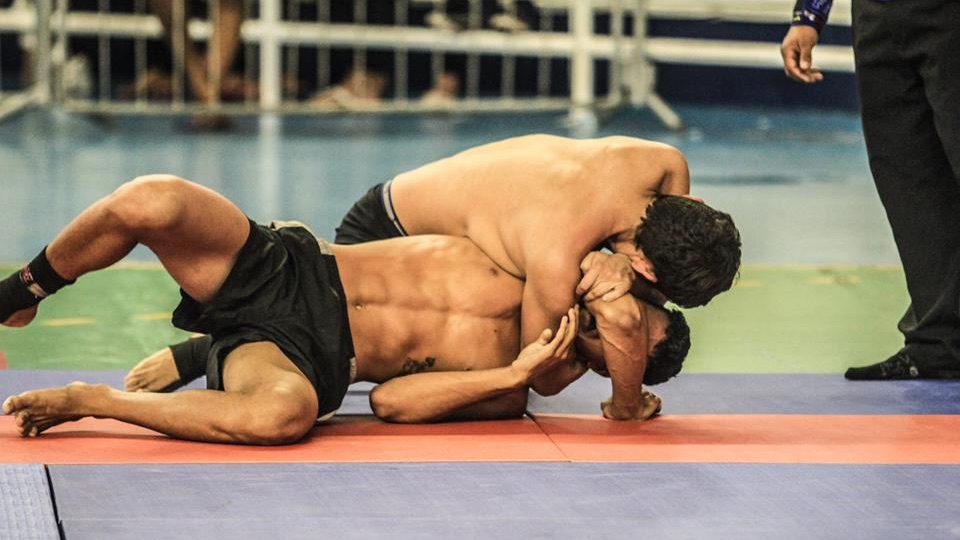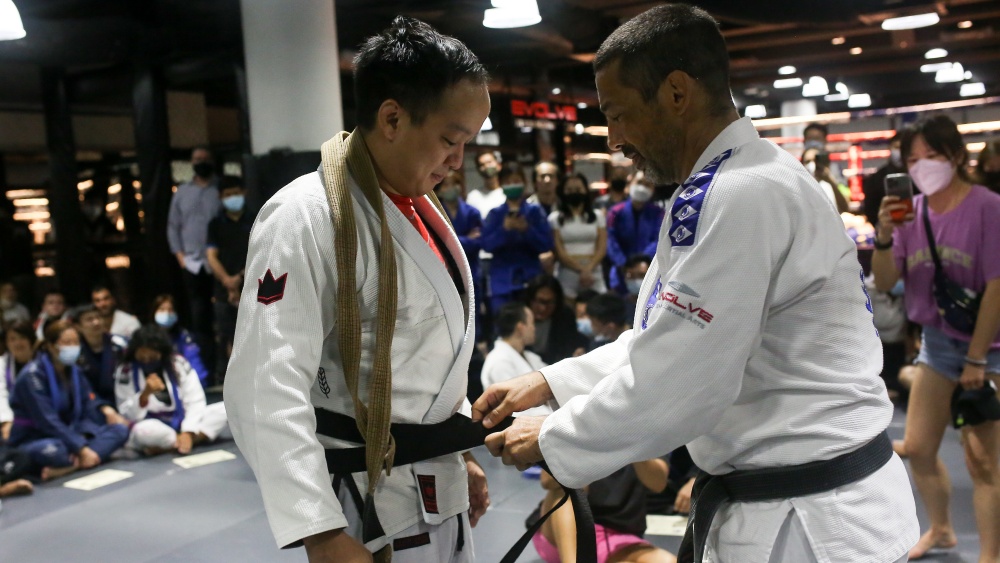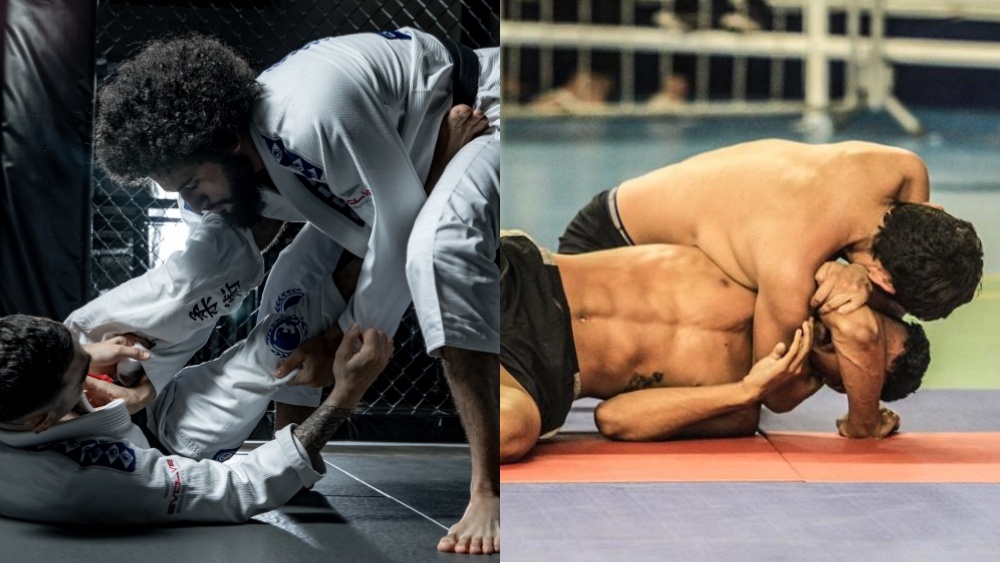Brazilian Jiu-Jitsu is much more popular than Luta Livre these days, but these two combat sports once had a heated rivalry as both camps fought for grappling supremacy. BJJ and Luta Livre were both developed in Brazil after Japanese judoka Mitsuyo Maeda came to Brazil to teach Kano Jiu-Jitsu, now known as Judo.
“Luta Livre” is a Portuguese word that translates to wrestling in English, while “Jiu-Jitsu” stands for gentle art. At first glance, some people might think Luta Livre is just a no-gi version of BJJ, but that could not be further from the truth. Both styles have distinct techniques and philosophies that make them utterly different combat styles. For example, Luta Livre teaches submissions first, while BJJ players look to secure favorable positions before working on submissions. Luta Livre also incorporates some techniques forbidden in BJJ, like strikes.
BJJ was created by Helio Gracie and his brothers, who trained under Maeda in Rio De Janeiro in the early 20th century. The Gracies modified some of the Judo techniques they learned and developed some unique techniques of their own to create BJJ.
Euclydes “Tatu” Hatem founded Luta Livre after he developed a passion for catch wrestling as an overweight child. Hatem trained with two accomplished wrestlers, Orlando Americo da Silva and Rufino dos Santos. He competed in catch wrestling from the 1930s to the 1950s and was virtually unbeatable during the period.
Hatem had a historic fight in 1940, defeating George Gracie. The victory solidified Luta Livre’s status as a formidable grappling art and set the stage for what ended up being one of the craziest rivalries in combat sports history.
There are two main styles of Luta Livre: Vale Tudo and Esportiva. Vale Tudo is the predecessor to modern mixed martial arts, allowing for submissions and strikes. Esportiva is the sports version of Luta Livre, and it looks a lot like no-gi BJJ.
The History Between Brazilian Jiu-Jitsu And Luta Livre
https://www.youtube.com/watch?v=9uVmf6NXyFY
The Gracies were one of Brazil’s wealthiest families when they started teaching people their new fighting style. Many of their students were well-off people who could afford to purchase a gi for their training. Luta Livre was more attractive to regular folks in Brazil since they didn’t need to buy a gi to train. As is now the case with no-gi BJJ, shorts, T-shirts, and an open mind were all students needed in Luta Livre.
That was one of the first divisions to develop between the two styles. BJJ was viewed as a more elitist style, while Luta Livre was the poor man’s fighting style. The rivalry between these two styles intensified when Hatem defeated George Gracie in 1940, legitimizing Luta Livre.
Little did both camps know that the rivalry was just getting started. Things intensified when a Muay Thai fighter, Mario Duma, and Charlie Gracie got into an altercation at a Luta Livre gym that eventually led to fists being thrown. Some speculate it was over a woman both men were involved with, but what we do know is that Charlie Gracie got the worst of it. Luta Livre was 2-0 against BJJ at this point.
The older members of the Gracie family were infuriated by the loss and rounded up some of their students. They went to the gym Duma trained at to challenge him. He accepted the challenge and ended up losing the fight.
The bad blood continued after the Gracies got their revenge, leading to three vs. three matches being set up to determine which school was superior. The event ended as a draw, and many spectators accused the referees of being partial to BJJ.
The rivalry between BJJ and Luta Livre hit an all-time high when Rickson Gracie and Hugo Duarte got into a brawl. Both men had been scheduled to fight, but Duarte allegedly pulled out, claiming he needed more time to prepare.
Rickson had no plans on waiting that long since he already intended to travel out of Brazil to take BJJ to other parts of the world. He found out Duarte was a regular at one of the local beaches and challenged him there. A fight ensured, and Duarte took a vicious beating as Rickson mounted him several times and unleashed ground strikes. It was a damaging blow to Luta Livre’s reputation, as Duarte didn’t seem to have any answers for Rickson.
The embarrassing beating badly bruised Duarte’s ego. In 1988, he grabbed about 60 of his students and went to a local Gracie Academy for a fight. Some eyewitnesses claim that Duarte’s posse had guns, knives, and other weapons when they stormed the Gracie academy. Fortunately, Helio Gracie was at the school then, and he managed to calm things down and devise a safer solution. Duarte and Rickson agreed to fight in the parking lot to settle their differences. Rickson emerged victorious once again, and Duarte was able to accept defeat this time around.
The win did wonders for BJJ’s reputation as it appeared to be a superior fighting style to Luta Livre.
The rivalry wasn’t entirely resolved at that point. Another three BJJ fighters vs. three Luta Livre fighters event was held in 1991 under no holds barred rules. All three BJJ fighters won their matchups, boosting BJJ’s popularity in Brazil.
The Luta Livre vs. BJJ rivalry spiraled out of control when Renzo Gracie fought Eugenio Tadeu in a BJJ vs. Luta Livre matchup. Renzo complained about getting kicked by spectators during the fight, and when he retaliated, a riot ensued, destroying the place with several people getting injured. The story was international news and led to the Brazilian government stepping in and forcing both sides to squash their beef or face criminal charges. That ended one of the most insane rivalries in martial arts history.
BJJ went on to become arguably the most effective martial art in the world, with BJJ players like Royce Gracie dominating the early days of mixed martial arts. Luta Livre has lost much popularity since then and remains a niche martial art that few people train in.
Differences Between Luta Livre And BJJ
Now that we’ve gone over the history between these two martial arts, let’s take a closer look at some of the differences that separate them:
1) Uniforms

BJJ players typically wear an outfit called a gi to train. It’s the traditional attire of BJJ that goes back to historical Jiu-Jitsu. The outfit consists of a fabric jacket, pants, and a belt. The belts have specific colors to signify each student’s rank.
The ranking system used in BJJ goes white, blue, purple, brown, and black. Many modern BJJ schools break white belts into different ranks by using stripes or colors that are not traditionally used in BJJ. It can take up to two years of training to go from white belt to blue belt, so many instructors these days break up the white belt rank into multiple ranks to recognize the accomplishments of white belts as their skills grow. The gi is used to execute specific techniques like a collar choke, and it also helps to absorb sweat when rolling, preventing their hands from getting slippery.
On the other hand, Luta Livre students do not have any traditional attire. Shorts are the only requirement, while T-shirts are often optional.
2) Fighting Philosophy
There are some significant differences in how BJJ and Luta Livre camps view fights. BJJ students are taught to stay on their opponents like wet rags, making it easier to keep dominant positions.
Luta Livre doesn’t emphasize being closing space as much as BJJ. They are taught to give opponents some space to maneuver so they can take advantage of the opportunity and transition to a submission. They view these moments as some of the best opportunities to secure submissions.
BJJ also tends to focus more on using leverage during fights to secure dominant positions and submissions. The style was initially developed for smaller fighters to defeat bigger, stronger opponents. Luta Livre focuses on using movement to create offensive and defensive opportunities instead of leverage.
3) Belt Colors

As we discussed earlier, the belts used in BJJ are white, blue, purple, brown, and black. How long it takes to reach the next level varies for each student, but most spend nearly two years earning each promotion. It takes most people more than ten years to earn their BJJ black belt. Many instructors add stripes to each color to signify their students’ progress after each color rank.
The belt colors used in Luta Livre are white, orange, blue, purple, brown, and black. Many practitioners reach the higher ranks within two years of training.
4) Competition

There are some significant differences in how BJJ and Luta Livre competitions are scored. Leg locks, heel hooks, and other attacks targeting the lower body are illegal in BJJ tournaments except for advanced fighters (brown and black belts). The rule doesn’t bother most BJJ students since BJJ schools generally don’t focus on leg locks and similar techniques as much as other grappling arts like Sambo and Luta Livre do.
Luta Livre allows for the use of leg locks at all levels, including beginners. Beginners can only go for straight ankle locks, while blue belts and higher can use whatever technique they want.
Other significant differences between how BJJ and Luta Livre competitions include:
- Standup: BJJ and Luta Livre matches start with both practitioners standing up, but strikes are allowed in the latter, leading to completely different approaches. BJJ fighters look to take their opponents to the ground or pull guard during their matches, while Luta Livre fighters are content to strike. Luta Livre fighters typically go to the ground when the striking isn’t going their way, or an opportunity for a takedown presents itself.
- Ground Game: BJJ fighters are extremely comfortable fighting off their backs, so they typically aren’t in a rush to attain the top position. Many BJJ fighters are comfortable pulling guard on opponents since they feel they still have the advantage even when they’re on their backs. Luta Livre fighters are not huge fans of guard fighting and prefer to secure top positions. They believe staying on top gives the offensive fighter more options, and they look to secure submissions as their opponents try to escape from disadvantageous positions. The fact strikes are allowed in Luta Livre has a lot to do with their approach.
- Trademark Positions: The guard is, without a doubt, the trademark position of BJJ. The position has changed how people worldwide view fights. Fighters on the bottom have historically been viewed as the person losing the fight, but BJJ changed that. A BJJ fighter’s guard is a perilous place to be, given the numerous submission, sweeps, getups, and reversals they can execute from the position. Luta Livre favors being on top, so they are not as competent at fighting on their backs. They have a more rounded approach to grappling as they train to submit opponents from any position and during scrambles.
- Submissions: BJJ and Luta Livre share many submissions like armbars, guillotines, and triangle chokes, but some BJJ techniques don’t carry over since Luta Livre fighters don’t wear gis. For example, you can’t perform a collar choke if your opponent doesn’t have a collar you can grab on to. BJJ schools also tend to neglect leg lock training since their students aren’t allowed to use these techniques during competitions. As a result, advanced BJJ students are often beginners when it comes to executing and defending against leg locks since everyone trains together. An instructor is unlikely to break down leg lock techniques if white and blue belts are training in the gym. Many BJJ schools hold classes for only advanced students so they can cover techniques that aren’t taught during general classes.
- Popularity: There’s no question about it – BJJ won the rivalry between these two sports. Mixed martial arts has a lot to do with the current popularity of BJJ, as members of the Gracie family dominated the early days of mixed martial arts. BJJ proved so effective that it took years for fighters who trained in different styles to learn how to defend themselves against BJJ fighters.
Which Is The Better Martial Art For Self-Defense?
Both styles are effective for self-defense, but some would say the slight edge goes to Luta Livre since its students also learn how to strike. Just hope your attacker isn’t a BJJ practitioner since we all know how that rivalry went. Luta Livre students learning how to strike takes away from time that could be used to learn ground fighting techniques, which allowed BJJ fighters to dominate Luta Livre fighters during their rivalry.
You may also like:
















